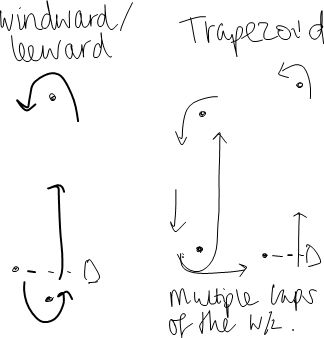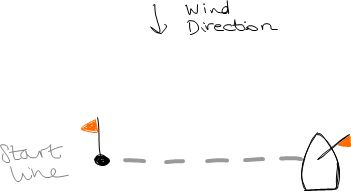Ten Minute Guide to Fleet Racing
This 'ten minute guide' was prepared by Rachel Grayson and Joe Penhaul Smith
What is fleet racing?
Arguably the simplest of the sailing disciplines, fleet racing is all about who is the fastest on the water. Competitors race around a set course of inflatable buoys and the first boat to complete the course and cross the finish line wins. This is the most common format of racing in the UK currently.
Normally in fleet racing, everyone sails the same class of boat, be that a dinghy or a yacht. However, when different classes want to race against each other, different handicaps are used to account for the speed differences between classes of boats.
A number called the Portsmouth Yardstick is generated for each class of boat. This allows you to adjust the times for each boat to make the racing fair. Alternatively, you can use those numbers to calculate different start times for each boat so they must race the same distance but faster boats are set off later than slower boats, this is the case for a pursuit race. More information on the calculation of Portsmouth Yardstick can be found on the RYA website.
The Course
The first leg is always upwind, but, other than that, the course can be very variable, unlike team racing or match racing. Normally, marks are rounded ‘to port’ which means you keep the buoy on your port side as you round the mark anti-clockwise.
Common courses include: Windward-leeward, Triangle or Trapezoid:

The Start
The start line is an imaginary line between the committee boat and a buoy, both normally display orange flags. The start line is set so that the first leg of the course is upwind.

A race is started by a countdown from five minutes with sound signals and flags at 5, 4, 1 and Go.
At 5 minutes, the class flag goes up on the committee boat so you know who is starting. This is very useful if there are multiple classes of boat at the event, or bigger fleets are split into different flights.
At 4 minutes, the preparatory flag goes up which tells you what to do if you are over the line before the Go signal. Normal signals are:

At 1 minute, the preparatory flag comes down.
At Go, the class flag comes down, and you can cross the start line. The race has begun!
The Finish
The finish line works just like the start line except the orange flags are usually replaced for blue flags, and it can be set at any angle to the wind.

Rules
Fleet racing uses the Racing Rules of Sailing (RRS) as set by World Sailing.Unlike team racing or match racing, there is rarely any need to hunt any of your opponents. Because racing is rarely umpired, this means the onus is on you to do penalty turns if you think you have infringed a rule, such as hitting a mark. For hitting a mark you should do a 360 degree spin, and for infringing another boat you should do a 720° degree spin.
The format
Fleet racing is the longest of all the different disciplines of sailing, with races usually lasting around an hour, so you will often only get through three races during a day. This means things are easier to keep track of as you will be on the same race course for most of the day against the same people.
Each result gives you the same number of points being the position you finished (on handicap corrected time, if relevant). The winners are the boats with the lowest accumulated point score over the event, with some events allowing you to discard your worst result, or results, depending on the length of the event.
The important thing
Fleet racing is longer than team or match racing with many more competitors on the water. This makes it sociable, fun and a real test of your personal sailing ability. So enjoy it.
About the authors
Rachel was BUSA Fleet Racing Officer in 2019. Her background is in fleet racing Mirrors which she raced competitively from 2009-2015, when she peaked aged 16. Since then, she has spent most of her time trying to team race Fireflies at the University of Nottingham.
Joe is the BUSA Development Officer 2019-2020.His fleet racing career started in Optimists at a young age and has since covered every boat he can lay his hands on, including Lasers, Scorpions and, more recently, a move to yacht fleet racing in the RC35 class. He spends most of his weekends in summer fleet racing with abandon, if not ability.